
Shinobi (忍) is a side-scrolling hack and slash video game produced by Sega, originally released for arcades on the Sega System 16 board in 1987. The player controls ninja Joe Musashi, to stop the Zeed terrorist organization from kidnapping students of his clan.

Wonder Boy in Monster Land, known by its original arcade release as Wonder Boy: Monster Land, is a platform video game developed by Westone Bit Entertainment and released by Sega in Japanese arcades in 1987 and for the Master System in 1988, with a number of other home computer and console ports following. The game is the sequel to the 1986 game Wonder Boy and takes place eleven years after the events in the previous game. After enjoying over a decade of peace on Wonder Land following the defeat of the evil King by Tom-Tom, later bestowed the title "Wonder Boy", a fire-breathing dragon called the MEKA dragon appeared; he and his minions conquered Wonder Land, turning it into "Monster Land". The people, helpless due to their lack of fighting skill, call for Wonder Boy, now a teenager, to destroy the monsters and defeat the MEKA dragon. Players control Wonder Boy through twelve linear levels as he makes his way through Monster Land to find and defeat the MEKA dragon. Players earn gold by defeating enemies and buy weapons, armor, footwear, magic, and other items to help along the way.
Ninja Gaiden is a media franchise based on action video games by Tecmo featuring the ninja Ryu Hayabusa as its protagonist. The series was originally known as Ninja Ryukenden in Japan. The word "gaiden" in the North American Ninja Gaiden title means "side story" in Japanese. The original arcade version, first two Nintendo Entertainment System games and Game Boy game were released as Shadow Warriors in PAL regions. As of 2008, the series has shipped over 7.7 million copies.

Bad Dudes Vs. DragonNinja, also known simply as either Bad Dudes or DragonNinja, is a side-scrolling cooperative beat 'em up game developed and released by Data East for arcades in 1988. It was also ported to many computer and game console home systems.

The Revenge of Shinobi, released in Japan as The Super Shinobi, is a hack-and-slash action video game developed and published by Sega in 1989. It was the first Shinobi game developed for the Sega Genesis, and was later released on the coin-operated version of that console, the Mega-Tech.

The Legend of Kage is a side-scrolling hack-and-slash game developed and published by Taito in 1985. In this game, the player controls the ninja Kage, with the objective being to get through five stages in order to save the princess Kirihime. These stages are littered with enemies, however Kage has various skills and weapons on his hands in order to get through them.
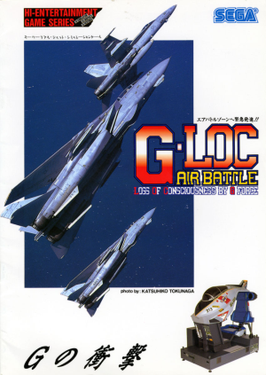
G-LOC: Air Battle is a 1990 combat flight simulator arcade video game developed and published by Sega. It is a spin-off of the company's After Burner series. The title refers to "G-force induced Loss Of Consciousness". The game is known for its use of the R360 motion simulator arcade cabinet. The arcade game was a commercial and critical success upon release.

Double Dragon is a 1987 beat 'em up video game developed by Technōs Japan and distributed by Taito for arcades across Asia, North America and Europe. It is the first title in the Double Dragon franchise. The game's development was led by Yoshihisa Kishimoto, and it is a spiritual and technological successor to Technos' earlier beat 'em up, Nekketsu Kōha Kunio-kun (1986), released outside of Japan by Taito as Renegade; Kishimoto originally envisioned it as a direct sequel and part of the Kunio-kun series, before making it a new game with a different cast and setting.

Shinobi Legions, known as Shinobi X in Europe and as Shin Shinobi Den in Japan, is an action game in the Shinobi series developed and published by Sega in 1995 for the Sega Saturn.

Shinobi is a series of hack-and-slash games created by Sega. The ninja (shinobi) Joe Musashi is the protagonist of the original series of games. The first Shinobi was released in 1987 as an arcade video game. Along with Alex Kidd and Sonic the Hedgehog, Joe Musashi has long been one of Sega's flagship characters, acting as a mascot for a short time in the late 1980s when ninjas were popular in mainstream media. The series' games are a showcase of Sega's technical accomplishment, noted for their high quality of graphics, gameplay and music, as well as their high level of difficulty. The Shinobi franchise sold more than 4.60 million copies.

The Cyber Shinobi is a side-scrolling hack and slash produced by Sega that was released for the Master System in 1990. It was the third Shinobi game for the console and served as a futuristic sequel to the original Shinobi. The game was released in Canada, Europe, Australia and Brazil, at a time when the Master System was discontinued in other markets.

Teenage Mutant Ninja Turtles, known as Geki Kame Ninja Den in Japan and Teenage Mutant Hero Turtles in Europe, is a 1989 side-scrolling action-platform game for the Nintendo Entertainment System released by Konami. In North America it was published under Konami's Ultra Games imprint in the US and the equivalent PALCOM brand in Europe and Australia.

Shadow Dancer: The Secret of Shinobi, also known simply as Shadow Dancer, is a side-scrolling action game developed and published by Sega for the Sega Genesis in 1990. It is the second game in the Shinobi series released for the Mega Drive, following The Revenge of Shinobi. However, it is not a continuation of the previous game, but rather a loose adaptation of the 1989 arcade game Shadow Dancer. Like in the original arcade game, the player controls a ninja followed by a canine companion. The Secret of Shinobi was well received by critics.
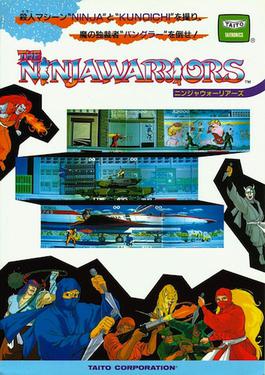
The Ninja Warriors (ニンジャウォーリアーズ) is a side-scrolling beat 'em up video game developed and released by Taito in 1987. The original arcade game situated one display in between projected images of two other displays, creating the appearance of a triple-wide screen. Ports were released for home systems including the Amiga, Atari ST, ZX Spectrum, Commodore 64, Amstrad CPC, PC Engine, and Sega Mega-CD.
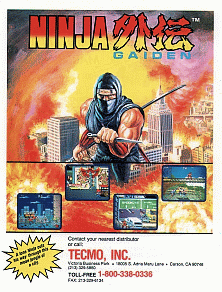
Ninja Gaiden, released in Japan as Ninja Ryūkenden and in Europe as Shadow Warriors, is a 1988 side-scrolling beat-'em-up game, originally released by Tecmo as a coin-operated arcade video game. It was first released in North America and Europe in late 1988, and then in Japan in February 1989. It was the first game released in the Ninja Gaiden franchise. The arcade game was a major commercial success in North America, becoming the highest-grossing arcade conversion kit of 1989 in the United States.

Space Gun is a 1990 first-person shooter arcade game released by Taito. The game is set aboard a crippled space station that has been overrun by hostile alien creatures. The objective is to rescue human crew members while destroying the alien creatures. The game lets the player shoot limbs off the creatures, resulting in blood splatters.
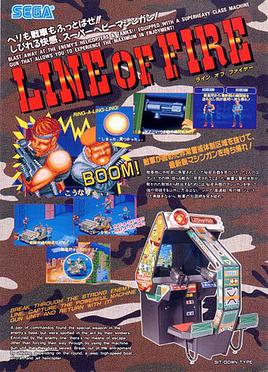
Line of Fire is a first-person light gun shooter game developed by Sega and released for arcades in 1989. It was released with two arcade cabinet versions, a standard upright and a sit-down cockpit, both featuring two positional guns. The cockpit design allows the player(s) to sit down while playing the game, while having two-handed machine guns, controlled by a potentiometer-controlled gun alignment software system. The game follows a two-man commando unit as they try to escape from a terrorist facility after seizing a prototype weapon.

Last Ninja 2: Back with a Vengeance is an action-adventure video game developed and published by System 3 for the Commodore 64, ZX Spectrum and Amstrad CPC in 1988 as a sequel to the 1987 game The Last Ninja. The Acorn Electron, BBC Micro, 1990: Amiga, Atari ST, MS-DOS and NES ports followed in 1989. The NES version of the game was named simply The Last Ninja. In 1990, the Last Ninja Remix edition of the game was re-released for 8-bit systems.
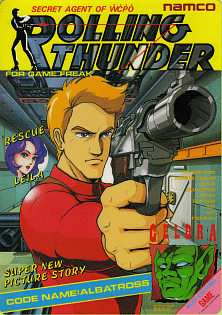
Rolling Thunder is a run and gun video game developed by Namco in Japan and Europe and released in 1986 as a coin-operated arcade video game using the Namco System 86 hardware. It was distributed in North America by Atari Games. The player takes control of a secret agent who must rescue his female partner from a terrorist organization. Rolling Thunder was a commercial success in arcades, and it was released for various home computer platforms in 1987 and the Nintendo Entertainment System in 1989. The original arcade game has been included in various classic game compilations as well. It influenced later arcade action franchises such as Shinobi and Time Crisis, which borrowed mechanics such as taking cover behind crates.

Ninja is a beat 'em up game developed by Sculptured Software and released by Mastertronic in 1986 for the Atari 8-bit computers, Commodore 64, and ZX Spectrum, then in 1987 for the Amstrad CPC, Amiga, Atari ST, and MS-DOS. An arcade version of the game was released in 1987 for Mastertronic's Arcadia Systems which is based on Amiga hardware. The Amiga, Atari ST, and Arcade versions were released as Ninja Mission. As a Ninja, the player attacks a fortress made of individual fixed screens which can be explored non-linearly.



















